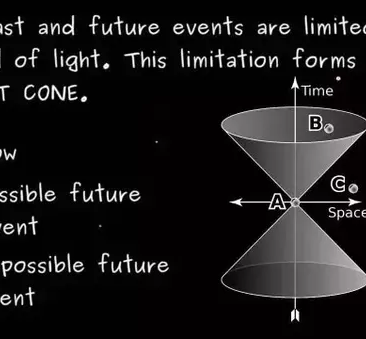The Postulates of Relativity and Their Implications 1

The Postulates of Relativity and Their Implications Part One
THE POSTULATES
In 1905 Albert Einstein, a twenty-six-year-old technical expert third class at the Swiss patent office in Bern, published three monumental papers in the Annalen der Physik. One of those papers set forth the theory now known as special relativity.l The theory is based on two postulates, whichI paraphrase as follows: Postulate 1 (Principle of Relativity): The laws of nature are the same in all inertial frames. Postulate 2 (Constancy of the Velocity of Light): The speed of light in empty space is an absolute constant of nature and is independent of the motion of the emitting body.
All of special relativity follows by logical deduction from these two postulates. The only other assumption required is that space is homogeneous and isotropic, that is, no region of space is intrinsically different from any other and there are no preferred directions in space. A principle of relativity had been propounded in the seventeenth century by Galileo but for a long time was believed to apply only to the laws of mechanics. Einstein's first postulate is simply the extension of Galileo's principle to encompass all the laws of physics, including those of electromagnetism and optics? Such a generalization had great intuitive appeal for Einstein. In his popular exposition of the theory, he says that a principle of such broad generality should hold with exactness in one domain of phenomena, and yet should be invalid for another, is a priori not very probable." 3 The quest for generality and for unifying principles guided Einstein in all his research.
The second postulate is the revolutionary part of special relativity. As Einstein says in the introduction to the 1905 paper, the second postulate is only apparently" irreconcilable with the first. What he means is that the two postulates are irreconcilable only if one insists on retaining the Galilean transformation, which implies that the speed of light (like that of anything else) should be different when measured by two sets of observers in relative motion. It also implies that the Galilean transformation, self evident though it may appear, must be rejected. The principal conceptual consequences of special relativity can, however, be demonstrated directly from Einstein's two postulates without employing the Lorentz transformation.
As noted, the second postulate provides a simple explanation for the null result of the Michelson-Morley experiment: if the speed of light is an absolute constant, the light travel times along the arms of the interferometer are always equal, no matter how the instrument is oriented. Hence, no fringe shift is to be expected as the interferometer is rotated. The Michelson-Morley experiment therefore provides strong (though indirect) support for the second postulate.
Direct experimental confirmation of the second postulate came only many years afterward. The most convincing data were provided by Alvager's experiment on the decay of neutral pions, in connection with Ritz's emission theory. In that experiment, pions moving at O.9998c were observed to decay into two photons (light pulses). One photon was emitted in nearly the forward direction (the direction of the decaying pion) and the other in nearly the opposite direction. According to Galilean relativity, the forward-moving photon should travel at speed 1.9998c and the other at only 0.0002c. Instead, both photons were observed to travel at speed c to within about three parts in 10^5 .
Demise of the Ether
In nineteenth-century electromagnetism, the ether played a central role. It provided a unique frame of reference in which Maxwell's equations hold and the speed of light is the same in all directions. According to Einstein's postulates, every inertial frame has that property. There remains no role for the ether to play in the description of natural phenomena; it has becoine superfluous.
Many physicists, including both Lorentz and Michelson, were reluctant to abandon the ether. Although Lorentz quickly accepted Einstein's relativity, he continued to maintain that a medium of some kind is needed as the carrier of the electromagnetic field. In his Theory of Electrons, published in 1909, he said, "I cannot but regard the ether, which can be the seat of an electromagnetic field with its energy and its vibrations, as endowed with a certain degree of substantiality, however different it may be from all ordinary matter." 4 Michelson expressed similar views. References to the ether continued to appear in the literature long after relativity had gained general acceptance. Gradually, however, the ether faded from discussion.
Special relativity dispenses also with the notions of absolute rest and absolute motion. So long as an ether was believed to exist, its rest frame provided a standard with respect to which absolute motion nlight be defined. A body could be said to be in a state of absolute rest if it was at rest relative to the ether. With the demise of the ether, all inertial frames are completely equivalent. There is no way to define absolute rest or absolute motion.
The first postulate implies that no experiment can have a result that favors one inertial frame over another. Nature imposes strict democracy among inertial observers; this rule dictates the outcome of many experiments. For example, consider two uniformly moving trains that approach each other on a straight track. The trains are equipped with identical speed-measuring devices, such as the radar employed by traffic patrols. Observers on each train aim their device at the other train and measure itsspeed of approach. How are the results of the two measurements related? In a world governed by Galilean relativity, it is easy to show that the two measured speeds must be equal. Suppose one train moves at 30 m/sec and the other at 40 m/sec relative to the ground. The distance between the trains diminishes by 70 m each second, and both speed indicators must read 70 m/sec.
In special relativity, this simple argument is not valid. As we shall presently discover, space and time have many unexpected properties. Observers on each train find that the other train is contracted and its clocks run slow. Hence it is not at all obvious that the two speed measurements should yield identical results. That outcome is demanded by the first postulate, however, for any other would violate the requirement of equality among inertial observers. If the two radars were to register unequal readings, which speed should be the greater? There is nothing in the problem to distinguish between the two trains, other than that they are moving in opposite directions; the isotropy of space assures us that this cannot make any difference. The only outcome consistent with Einstein's first postulate is that the two measured speeds are equal.
 The Postulates of Relativity and Their Implications 2
The Postulates of Relativity and Their Implications 2

“Don't cry because it's over, smile because it happened.”
― Dr. Seuss





